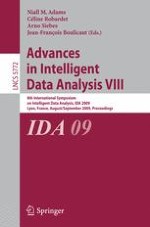2009 | Buch
Advances in Intelligent Data Analysis VIII
8th International Symposium on Intelligent Data Analysis, IDA 2009, Lyon, France, August 31 - September 2, 2009. Proceedings
herausgegeben von: Niall M. Adams, Céline Robardet, Arno Siebes, Jean-François Boulicaut
Verlag: Springer Berlin Heidelberg
Buchreihe : Lecture Notes in Computer Science
